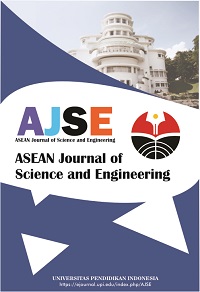Analysis of Mixture Paste of Cassava Peel and Pineapple Peel as Electrolytes in Bio Battery
Abstract
Keywords
Full Text:
PDFReferences
Akbar, S. A., Armelianda, D., and Muttakin, M. (2018). Electrolyte performance of noni fruit extracts (Morinda Citrifolia L.) for C–Zn batteries. Chemical Engineering Research Articles, 1(2), 74-81.
Ansanay, Y. O., Walilo, A., and Togibasa, O. (2019). Novelty potency of utilizing local betel nut (areca catechu) of papua as a bio-battery to produce electricity. International Journal of Renewable Energy Research (IJRER), 9(2), 667-672.
Arie, A. A., Kristianto, H., Demir, E., and Cakan, R. D. (2018). Activated porous carbons derived from the Indonesian snake fruit peel as anode materials for sodium ion batteries. Materials Chemistry and Physics, 217, 254-261.
Fauzia, S., Ashiddiqi, M. A. H., and Khotimah, A. W. I. K. (2019, March). Fruit and vegetables as a potential source of alternative electrical energy. Proceeding International Conference on Science and Engineering, 2, 161-167.
Kareem, S. O., Akpan, I., and Alebiowu, O. O. (2010). Production of citric acid by Aspergillus niger using pineapple waste. Malaysian Journal of Microbiology, 6(2), 161-165.
Provera, M., Han, Z., Liaw, B. Y., and Su, W. W. (2016). Communication—Electrochemical power generation from culled papaya fruits. Journal of The Electrochemical Society, 163(7), A1457.
Supriyanto, A., Surtono, A., and Sutanto, T. (2019). Analysis of cassava peel paste as an electrolyte of electrical energy source. Journal of Technomaterials Physics, 1(1), 15-21.
Togibasa, O., Haryati, E., Dahlan, K., Ansanay, Y., Siregar, T., and Liling, M. N. (2019). Characterization of bio-battery from tropical almond paste. Journal of Physics: Conference Series, 1204(1), 012036.
Tuurala, S., Kallio, T., Smolander, M., and Bergelin, M. (2015). Increasing performance and stability of mass-manufacturable biobatteries by ink modification. Sensing and Bio-Sensing Research, 4, 61-69.
Zhang, Y., Gao, Z., Song, N., and Li, X. (2016). High-performance supercapacitors and batteries derived from activated banana-peel with porous structures. Electrochimica Acta, 222, 1257–1266.
DOI: https://doi.org/10.17509/ajse.v1i2.34225
Refbacks
- There are currently no refbacks.
Copyright (c) 1970 Universitas Pendidikan Indonesia

This work is licensed under a Creative Commons Attribution-ShareAlike 4.0 International License.












